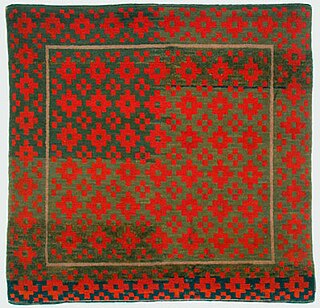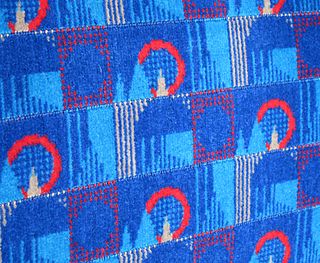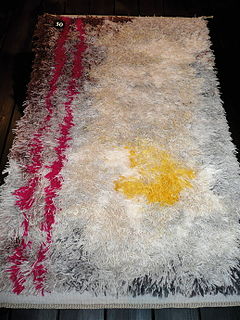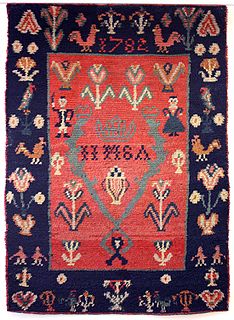
A flokati rug is a woven wool rug. They are shaggy in appearance, and are thick and soft. Modern wool or synthetic rugs may be purchased in a variety of colours.

A flokati rug is a woven wool rug. They are shaggy in appearance, and are thick and soft. Modern wool or synthetic rugs may be purchased in a variety of colours.
The word comes from the Aromanian floc, from Latin floccus. [1] Another name for a similar style of rug is βελέντζα /vel'endza/ < Turkish velense, possibly via Albanian velentse. [1]

Flokati were popular in the 1970s. [2] The word first appeared in English in 1967. [3] The term was created by the Greek Ministries of Finance, Industry, and Commerce to apply to a rug with certain specifications: hand woven in Greece, made of 100% wool (warp, weft, and pile), with total weight of at least 1800 grams of wool per square meter. The rug must also be "subjected to the water friction process" to create the unique pile. [4]
Gagalis Co. imported flokati from Greece starting in 1970 and sold them as "a new look in casual floor coverings." [5]
In the October 2005 Cosmo Girl, designer Mark Montano suggested a flokati rug as a solution to the question, "What if my dormmate is the complete opposite of me?!" [6]

A rug is a piece of cloth, similar to a carpet, but it does not span the width of a room and is not attached to the floor. It is generally used as a floor covering, or as a decorative feature. Rug making is the process of crafting a rug from various textile materials. Historically, there has been a variety of methods of rug making, including braiding, hooking, and weaving. These processes can be carried out by hand, using smaller tools like a latch hook, or using a weaving machine. Rag rugs are a historically notable and widespread form of hooked rug making. Rug hooking is both an art and a craft where rugs are made by pulling loops of yarn or fabric through a stiff woven base such as burlap, linen, or rug warp. The loops are pulled through the backing material by using a crochet-type hook mounted in a handle for leverage.

A carpet is a textile floor covering typically consisting of an upper layer of pile attached to a backing. The pile was traditionally made from wool, but since the 20th century, synthetic fibers such as polypropylene, nylon or polyester are often used, as these fibers are less expensive than wool. The pile usually consists of twisted tufts that are typically heat-treated to maintain their structure. The term carpet is often used in a similar context to the term rug, but rugs are typically considered to be smaller than a room and not attached to the floor.

Tibetan rug making is an ancient, traditional craft. Tibetan rugs are traditionally made from Tibetan highland sheep's wool, called changpel. Tibetans use rugs for many purposes ranging from flooring to wall hanging to horse saddles, though the most common use is as a seating carpet. A typical sleeping carpet measuring around 3 ft × 5 ft is called a khaden.

A Persian carpet or Persian rug, also known as Iranian carpet, is a heavy textile made for a wide variety of utilitarian and symbolic purposes and produced in Iran, for home use, local sale, and export. Carpet weaving is an essential part of Persian culture and Iranian art. Within the group of Oriental rugs produced by the countries of the "rug belt", the Persian carpet stands out by the variety and elaborateness of its manifold designs.

A kilim is a flat tapestry-woven carpet or rug traditionally produced in countries of the former Persian Empire, including Iran, the Balkans and the Turkic countries. Kilims can be purely decorative or can function as prayer rugs. Modern kilims are popular floor coverings in Western households.

The Iranian city of Isfahan has long been one of the centres for production of the famous Persian carpet. Isfahani carpets are renowned for their high quality. The most famous workshop in Isfahan is Seirafian. In Europe they became incorrectly known as Polish rugs because of the trade route from Persia to France running through Poland.

Uşak carpets, Ushak carpets or Oushak Carpets are Turkish carpets that use a particular family of designs, called by convention after the city of Uşak, Turkey – one of the larger towns in Western Anatolia, which was a major center of rug production from the early days of the Ottoman Empire, into the early 20th century.

Rug hooking is both an art and a craft where rugs are made by pulling loops of yarn or fabric through a stiff woven base such as burlap, linen, or rug warp. The loops are pulled through the backing material by using a crochet-type hook mounted in a handle for leverage. In contrast latch-hooking uses a hinged hook to form a knotted pile from short, pre-cut pieces of yarn.
An oriental rug is a heavy textile made for a wide variety of utilitarian and symbolic purposes and produced in "Oriental countries" for home use, local sale, and export.

Moquette, derived from the French word for carpet, is a type of woven pile fabric in which cut or uncut threads form a short dense cut or loop pile. As well as giving it a distinctive velvet-like feel, the pile construction is particularly durable, and ideally suited to applications such as public transport. Its upright fibres form a flexible, non-rigid surface, which are constantly displaced to give durability and anti-stain benefits. Traditional moquette fabrics are made from a wool nylon face with an interwoven cotton backing.

Anatolian rug is a term of convenience, commonly used today to denote rugs and carpets woven in Anatolia and its adjacent regions. Geographically, its area of production can be compared to the territories which were historically dominated by the Ottoman Empire. It denotes a knotted, pile-woven floor or wall covering which is produced for home use, local sale, and export. Together with the flat-woven kilim, Anatolian rugs represent an essential part of the regional culture, which is officially understood as the Culture of Turkey today, and derives from the ethnic, religious and cultural pluralism of one of the most ancient centres of human civilisation.

A rya or rye is a traditional Scandinavian wool rug with a long pile of about 1 to 3 inches. They are made using a form of the Ghiordes knot to make the double-sided pile fabric. Though rya means "rug" in English, the original meaning in Sweden of rya was a bed cover with a knotted pile. The first ryas originated in the early fifteenth century as coarse, long-piled, heavy covers used by mariners instead of furs. As time progressed, the rugs have evolved to be lighter and more colorful. The insulation that ryas provide protects against the cold Scandinavian climate. Ryas are a knotted pile carpet, with each knot composed of three strands of wool, which enables the rug to exhibit rich texture from all the different shades of color. The name originates from a village in southwest Sweden. The term rya may also refer to a breed of sheep whose wool is used to make rya carpets.

Hereke carpets are Turkish handmade carpets produced and sold in Hereke, a coastal town in Turkey. For a long time, they used to be produced only in Hereke, 60 km from Istanbul. The materials used are silk, a combination of wool and cotton, and sometimes gold or silver threads.

Ryijy is a woven Finnish long-tufted tapestry or knotted-pile carpet hanging.

Ardabil rugs originate from Ardabil located in the province of Ardabil Province in northwestern Iran, 639 kilometers from Tehran. Ardabil has a long and illustrious history of Persian carpet weaving.

A Turkmen rug is a type of handmade floor-covering textile traditionally originating in Central Asia. It is useful to distinguish between the original Turkmen tribal rugs and the rugs produced in large numbers for export mainly in Pakistan and Iran today. The original Turkmen rugs were produced by the Turkmen tribes who are the main ethnic group in Turkmenistan and are also found in Afghanistan and Iran. They are used for various purposes, including tent rugs, door hangings and bags of various sizes.
The Hat and Fragrance Textile Gallery is an exhibit space at Shelburne Museum in Shelburne, Vermont which houses quilts, hatboxes, and various other textiles. The name "Hat and Fragrance" refers both to Electra Havemeyer Webb's collection of hatboxes and to the fragrant, herbal sachets used to preserve textiles. In 1954, Shelburne Museum was the first museum to exhibit quilts as works of art; prior to this exhibition quilts were only shown as accessories in historic houses.

The term Armenian carpet designates, but is not limited to, tufted rugs or knotted carpets woven in Armenia or by Armenians from pre-Christian times to the present. It also includes a number of flat woven textiles. The term covers a large variety of types and sub-varieties. Due to their intrinsic fragility, almost nothing survives—neither carpets nor fragments—from antiquity until the late medieval period.
Scandinavia has a long and proud tradition of rug-making on par with many of the regions of the world that are perhaps more immediately associated with the craft—regions such as China and Persia. Rugs have been handmade by craftspeople in the Scandinavian countries of Denmark, Finland, Norway, and Sweden for centuries, and have often played important cultural roles in each of these countries. Contemporary Scandinavian rugs—most especially Swedish rugs—are among the most sought after rugs in the world today, largely due to the contributions of designers like Marta Maas-Fjetterstrom. The story of Scandinavian rugs is a vital chapter in the cultural study of Scandinavia, as it reveals a great deal about the aesthetic and social conventions of that region.

Carpets and rugs have been handmade in Sweden for centuries, taking on many different forms and functions over the course of time. Rugs woven in the traditional Oriental manner, especially in the Ottoman Empire and points east, were originally brought to Sweden over trade routes as early as the early Middle Ages. In the centuries that followed, Swedish rug-makers often infused their works with themes and motifs traditionally found in Oriental rugs. Eventually, Swedish rug-makers would begin to use Oriental rug-making techniques, but themes and motifs more consistent with the artistic and cultural heritage of Sweden. By the early modern periods, rugs had long been an important avenue of art – especially folk art – in Swedish culture. By the beginning of the twentieth century, the craft was seen as being an important artistic and cultural practice throughout Sweden, and designers began to make rugs that had a broad international appeal. Swedish rugs from the mid-twentieth century remain among the most desirable and sought after in the rug world.